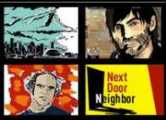George Clooney
Monday, September 11th, 2006Refusing George Clooney’s Burrito
By Tom Nawrocki
It was an early October afternoon, still a hot part of the year in Hollywood, when I first laid eyes on George Clooney. We were in the lobby of a low-slung brick studio in Burbank where Clooney was to record the commentary for the Good Night, and Good Luck DVD; I was there for Rolling Stone writing a story about DVD commentaries. He’s not very tall for such a manly heartthrob, maybe five-eleven in his big clunky black shoes. But goodness, is that man ever tan. This was a Saturday, so he wasn’t working at his day job and I don’t think there was any makeup involved, but George’s hair is dark brown verging on black, and the skin tone of his forehead was just a shade or two lighter than his hair.
We got down to business around 2pm, with Clooney and his co-writer/producer/old friend Grant Heslov taping their audio track with more than their share of grogginess and false starts. About 20 minutes in, a hesitant voice came in to the headphones from the control room: “Excuse me? Your lunch is here.â€
In came a whole bag of steak burritos from some dive across the street. George had ordered way more food than he and Grant wanted, just in case the random publicists and technicians in the room were hungry. Now, you might think that George Clooney is so rich he can afford to buy burritos for the entire adult populace of Burbank, but just as likely, he knew that there was no way he was paying for any of this. Someone at the front desk paid for these burritos long before George had a chance to. When you’re George Clooney, you can order a hundred burritos and always expect someone else to cover for you.
Clooney made it clear that this was not just his lunch but his breakfast, but the rest of us seemed to have eaten. There was at least one steak burrito unclaimed in the bag, and George, rather generously, I thought, asked me if I wanted it. No thanks, I said. (I had had lunch already at In-n-Out Burger, where I have nearly all my post-morning meals when I am on the West Coast.)
“You’re gonna regret it,†George said. “These are really good burritos.†He undercut his own case a few minutes later, when a publicist mentioned to him a recording of an Edward R. Murrow speech that had been downloaded to the Internet; Clooney replied, “I’m gonna download that burrito in about 10 minutes.â€
The rest of the afternoon unwound rather unspectacularly, although we did talk briefly about baseball as we parted. It was the last weekend of the 2005 regular season, and in the parking lot, George spoke enthusiastically although not very knowledgeably about the postseason permutations still in play. And then he and Grant were off, in a big black Jaguar, no doubt in search of women who would not refuse George’s burrito. I bet they didn’t have to ask very many of them.
Afterward, I told a friend of mine that Clooney seemed like just about the happiest guy on earth that afternoon. “If that bastard’s not happy,†he replied, “there’s no hope for the rest of us.†There’s not much hope for me, anyway — for various reasons unrelated to the quality of the work, the story never ran, in Rolling Stone or anywhere else. Good Night, and Good Luck is already out on DVD, so it will never run. I haven’t bothered watching the movie again. But I have had the occasional burrito.




